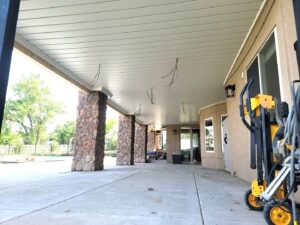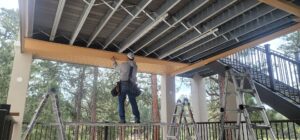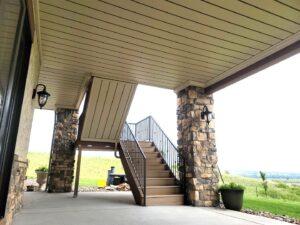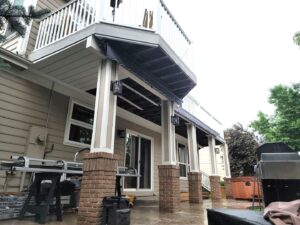
Corners Galore!
Our team really enjoyed working in this beautiful underdeck system in Arvada. The Sandy Beige color matches the walls and existing color pallet perfectly. This
Support posts which are mounted in the interior of the deck will be flashed and sealed. There may be occasions where you see drips from time to time.
Some railing systems require the support posts to protrude through the deck surface and anchor to the structure below. In most cases it is impossible to adequately flash these areas. Some dripping may occur over time.
Any features on the deck which prohibit the insertion of flashing material. To the best of our ability we will identify these areas to the homeowner and advise as to whether the ‘No Leak’ warranty can be applied to these area(s).
The homeowner must ensure that the deck ledger board has been properly flashed prior to installation of the Under Deck Oasis. Absence of this flashing will allow water to drain behind the ledger and down the wall. This phenomenon is outside of the systems ability to redirect this water.
Masonry work can seep water from time to time. This phenomenon is outside of the systems ability to re-direct this water.
Similar to the above ‘porous masonry’ issue, any water which is entering the building structure above the deck surface and exiting below the deck onto the patio is outside of the systems ability to re-direct this water.
It is important that during the winter months no external heat sources such as lights or heaters be kept operating for a lengthy period of time.
Sometimes with older decks the structural wood may split or crack. The warranty will cover this as long as we can adequately flash and seal these areas during the installation.
Lumber that is lapped together has a joint between the pieces. The warranty will apply only if we have access to cover the top of the joist with flashing.
This is a temporary condition. Leaks of this type will only occur in extreme conditions. Once the condition has subsided the leaks should not reoccur.
Rarely there may be an area that is impossible for our installer to reach in order to properly flash or seal the system.
Excessive tree and bird feeder debris could potentially clog the system if they are unattended to.
Pet urine in the system will destroy the aluminum and will not be covered by warranty.
A downspout protruding through the system is considered a non-standard installation and may result in leaks.
Excessive water dumping into the system from an external downspout could create system overflow and/or leaks.
When sistered joists rest on top of a beam, it is impossible to properly flash and seal. Other potential issues with sistered joists and beams are possible.
The major issue that leads to the under-deck system clogging is overly large, or irregular gaps between the deck boards, that allow the debris to get through. The worst problems happen in the Spring time when seed pods and other tree debris are most prevalent.
Pine needles are also a primary culprit because they can get through the gaps between deck boards so easily. Most of this debris will wash out of the system without any problem, but can sometimes bunch up around the outlet of the downspout.

Our team really enjoyed working in this beautiful underdeck system in Arvada. The Sandy Beige color matches the walls and existing color pallet perfectly. This

What a beautiful combination indeed! This gorgeous projected completed in Colorado Springs was a unique combination of color and deck type. The homeowners here went

In a way, yes! This particular project had 3 main decks, 2 sets of stairs, a landing & a cantilever. Although it took about 7

Our team is super proud of this job. It took about 2 days and went as smooth as could be. The homeowners just moved in

This job was unique as the main part of the deck wasn’t very wide at all – less than 5′! The family here appreciates their

This was an amazing project completed in Backcountry. The homeowner had an upper and a lower deck – both of them which they used! We
It’s our customers that make our business work. You’re amazing, and your home is amazing. You inspire us to do an amazing job installing our amazing system.
Let’s be amazing together.

© 2022 Amazing Underdeck